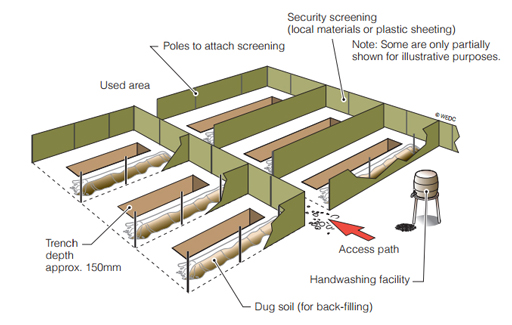14.4.2 Latrine provision and excreta disposal
The Sphere standards for excreta disposal state that the environment should be free of faeces and that people should have adequate and appropriate toilet facilities. It then goes on to list more specific requirements which include:
- a maximum of 20 people use each toilet
- toilets are no more than 50 m from dwellings
- they can be used safely by all sections of the population including children, older people, pregnant women and persons with disabilities
- they are sited in such a way as to minimise security threats to users, especially women and girls, throughout the day and the night
- they are sufficiently easy to use and keep clean and do not present a health hazard to the environment
- they allow for the disposal of women’s menstrual hygiene materials and provide women with the necessary privacy for washing and drying menstrual hygiene materials
- separate, internally lockable latrines/toilets for women and men.
The Sphere standards also lists the possible options for safe excreta disposal and when they would be used in an emergency situation (Table 14.2).
| Excreta disposal type | Phase of use/comments |
| Demarcated open defecation area (e.g. with sheeted-off segments) | First phase (2–3 days) when there may be a huge number of people needing immediate facilities |
| Trench latrines (Figure 14.3) | First phase for up to two months |
| Simple pit latrines | From the start through to long-term use |
| Ventilated improved pit (VIP) latrines | For medium- to long-term use |
| Ecological sanitation (ecosan) with urine diversion | In situations where there is a high water table or flooding. May be required from the start and suitable for medium to long term use |
| Septic tanks | Mid- to long-term phases |

It is important to remember that successful excreta disposal programmes are based on an understanding of people’s varied needs as well as on the continuing participation of the users. It may not be possible to make all latrines acceptable to all groups and special latrines may need to be constructed for the vulnerable sectors of a community. These may include children, older people and disabled people. They may require potties or latrines with lower seats or supporting hand rails.
Keeping latrines clean is an important on-going task in an emergency situation. If latrines are not kept clean then people will prefer not to use them and find alternative uncontrolled areas to defecate in. Latrines will be more likely to be kept clean if users have a sense of ownership. This is encouraged by promotional activities, having latrines close to where people sleep and involving users in decisions about their design and construction and in the development of rules on proper operation, maintenance and use.
Inappropriate siting of latrines may also make women and girls more vulnerable to attack, especially during the night. Ways should be found to ensure that women feel, and are, safe using the latrines provided. Where possible, communal latrines should be provided with lighting or families provided with torches. The input of the community should be sought with regard to ways of enhancing the safety of all users.
14.4.1 Water supply
